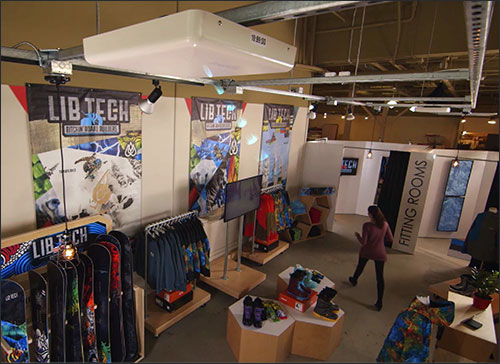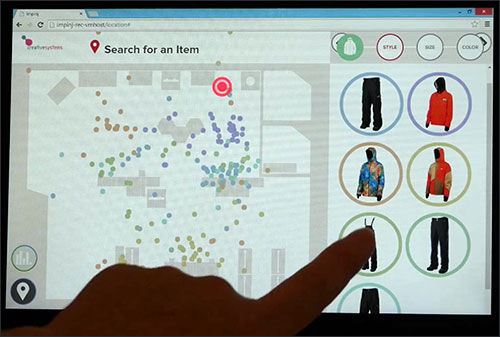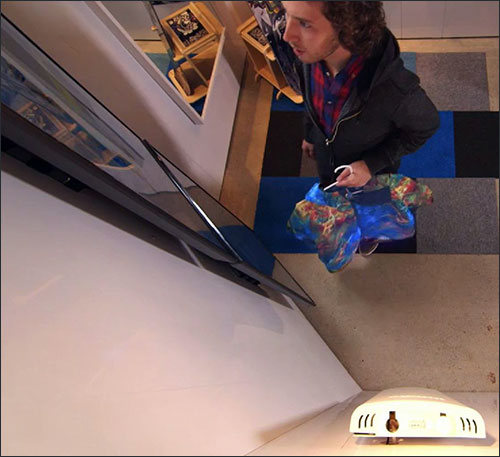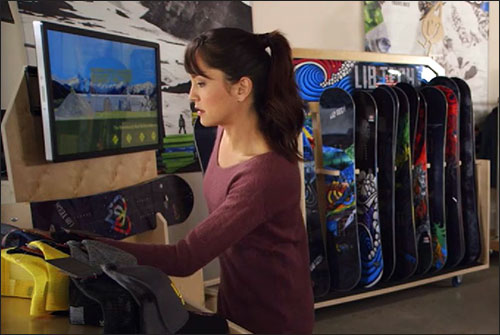During the development of its xArray reader in 2013 (see Impinj Unveils New UHF Readers for RTLS Applications, Embedding in Other Devices), Impinj realized that it had outgrown its research and development space. The xArray reader was being designed to identify the locations of merchandise throughout a store or other open space, providing real-time tracking of items via passive EPC Gen 2 ultrahigh-frequency (UHF) tags. The RFID company, residing on a single floor of an office building in Seattle’s Fremont neighborhood, felt that it would require additional space in order to be able to fully test and measure what the xArray would be able to do as it was being developed.
Fortunately, the supermarket across the street vacated its space, and Impinj was able to lease the building and moved in. The result is the Retail Experience Center (REC), a 1,500-square-foot windowed area in which the RFID company has set up a mock store containing up to 500 tagged products, selling snowboarding equipment and clothing (as well as jewelry), and the Impinj Design Lab (IDL), an 8,500-square-foot space in the back of the building, in which testing and development are underway (see RFID News Roundup: Impinj Opens Retail Experience Center).

The site is a good fit for Fremont (known as the Silicon Canal), where technology companies such as Google, Adobe and Tableau Software share space with shopping and dining establishments that target creative, young and educated consumers. At the new lab and the REC, Impinj’s customers and other interested parties can view the store of the future, while the company’s engineering takes place in the back room. This helps the company not only showcase what the xArray and Impinj’s other RFID readers and tags made with its chips can do, but also creates a forum for conversations between potential users and the engineers who design the technology to better create solutions for tomorrow’s use cases.
This is all part of a new stage of growth for Impinj, says Chris Diorio, Impinj’s CEO, involving EPC RFID technology and the ways in which passive UHF tags can be used affordably to collect real-time, location-based data.
In fact, the company’s swelling ranks (with 20 new hires during the past six months across all of its departments) has led it to seek a new home for its offices in the South Lake Union area of Seattle, while the IDL and REC will remain where they are. The firm now has about 150 employees, known internally as “Pinjers.” Earlier this month, Impinj announced plans to move its headquarters to the 11th and 12th floors of a new 14-story office on Fairview Avenue toward the end of 2015. The new 52,000-square-foot space is 50 percent larger than its current 36,000-square-foot HQ in Fremont.
At the ILD, Alberto Pesavento, Impinj’s chief hardware architect, has led development work related to the xArray as it moves into full production. Researchers have used the space to test the xArray with a floor grid of 13,000 passive UHF tags made with Impinj’s Monza 4, Monza 5 and R6 chips. The tags, manufactured by Impinj and other vendors, are sandwiched between foam mats above the rebar concrete floor, and are designed to protect the transponders from potential damage due to people trodding on them. With multiple xArrays mounted on the ceiling, Impinj has tested a variety of scenarios involving various tags positioned at numerous locations and in different orientations on the floor, in order to learn how to optimize what Impinj calls its Item Intelligence solutions.
An important part of the testing has included the latest member of the tag family, the Monza R6 chip (see New Impinj Chip Promises Higher Sensitivity, Read Range and Flexibility). “The xArray development proceeded side by side with Monza R6 development,” Pesavento explains, “and, in fact, was designed from the ground up with the xArray, to achieve the best performance when deployed together.”
What’s been found in the lab, Pesavento says, is that Monza R6 provides double the sensitivity range in comparison with previous Monza tags, and when read by the xArrays within the IDL’s large space.

The space was initially intended for lab work only, according to Larry Arnstein, the company’s VP of business development, but Impinj saw an opportunity to share the results of its development with potential customers. So the front section is dedicated to demonstrating how Impinj’s Item Intelligence technology works in the real world. For now, that area is dedicated to the shopping experience. To create the REC, Impinj collaborated with InMotion Software and Creativesystems, which provided software. The mock store is using Smartrac and Data2 tags, as well as snowboarding products provided by Mervin Manufacturing, which happens to have its own storefront in the same neighborhood. The REC staff also uses Hewlett-Packard tablets donated by Intel to display those applications.
Within the REC, a shoe display wall features a single Speedway Revolution reader and 32 antennas, with each antenna dedicated to a shelf for a single shoe. The shoe is tagged, and when it is removed from the shelf, the reader captures that change in read data, prompting the displaying of content regarding that tagged product on a large screen.
In another section of the mock store, Smartrac tags made with Monza R6 chips have been attached to a collection of snowboards on display. When a snowboard is removed from the display and placed in a rack under a large screen, another Speedway reader containing an Impinj Brickyard antenna installed in the rack captures the tag’s ID number and launches video content specific to that product.
Inside the fitting room, an Impinj xPortal gateway reader can interrogate tags on products such as pants, jackets or other clothing that are brought in by a visitor, and then prompt the displaying of other items that would go well with those garments.
Within a cabinet under a counter, rings, bracelets and other items are on display. Impinj has attached a Data2 tag (made with Impinj chips) to each item, and a handheldTechnology Solutions Ltd. (TSL) reader can be used to capture all of the jewelry’s tag ID numbers. The software then displays an alert if any items are missing.
At the point of sale, an Impinj Speedway reader under the counter reads the tags of products placed there. This enables a store’s software to remove those items from the inventory list as they are sold.
With the xArray reader installed in the ceiling, a touch screen can be used to view the location of each tagged item within the store, by selecting a particular product size, type or color. The software then displays icons on a map of the store floor, indicating where that item can be found.

Creativesystems’ Quickstart software application can be used to collect inventory data, as well identify where specific merchandise is located on the sales floor and in the back room. InMotion’s software provides the data required to operate the RFID-enabled store displays, including the interactive snowboard display, the smart fitting room and the jewelry display.
“The xArray is a paradigm shift in the [RFID] industry,” says Diorio, who cofounded Impinj in 2000 and served as the company’s CTO before accepting the position of CEO last month, replacing outgoing William Colleran. The new reader offers what Impinj calls “Always On” functionality, so that for the first time, stores or other end users, such as health-care facilities or distribution centers, can view a tagged item’s location or movements via passive UHF RFID technology.
This paradigm shift, Diorio says, was necessary in order to bring RFID beyond the level of a technology that simply scans tags on products somewhat faster and easier than bar codes. When users began utilizing passive RFID in addition to—or instead of—bar-code labels for inventory tracking, he notes, “the shift wasn’t that huge,” since the use in stores typically consisted of the sales staff walking around a facility and coming within range of a tag to capture data. Now, with the xArray system, the information is simply available to workers when they need it.
That offers opportunities for the item-level tracking of goods for retailers or other businesses in a variety of new ways, Diorio reports. This includes allowing customers to locate a specific item on a virtual map, issuing an alert if an item leaves its authorized area or simply identifying when something has been mis-shelved.
“I’m pretty excited right now,” Diorio says, when considering all of the possibilities ahead for UHF RFID. The xArray product, as well as the expected release of the company’s Gen 2 V2 tag chips (featuring greater functionality than prior models) sometime in 2015, along with the Item Intelligence software platform now under development, will make RFID able to accomplish functions not previously available, he says.
Impinj’s RFID chips based on the EPC Gen 2 V2 standard will also provide enhanced user memory, Diorio says, as well as enable the cryptographic authentication of tags to reduce counterfeiting. What’s more, it will allow the ability to hide portions of data via an “untraceable” function.

Impinj is currently developing location-based software for use with the xArray reader. That new software, Diorio says—which will be known as Item Intelligence—will identity, locate and authenticate items (in other words, it will confirm that a product has an authorized RFID tag is and thus not a counterfeit). However, he adds, additional details will not be released until the product is launched.
The Item Intelligence software will, however, still require that a partner software firm use that location-based software to create its own full solution specific to its customers, which could be retailers, health-care companies, manufacturers or warehouses. The software will provide a consumable stream of meaningful item data, Diorio says, as opposed to a torrent of RFID data. It will also simplify device management and control, he adds, making it easier to develop and deploy solutions. In the meantime, existing systems used by customers of the xArray readers rely on software fully developed by Impinj’s partners. The new Item Intelligence software is expected to become available during the second half of 2015.
Diorio also chairs the RAIN Alliance, which he expects will promote and certify passive UHF RFID technology, similar to the way in which the Wi-Fi Alliance promotes and certifies Wi-Fi products that meet accepted criteria. RAIN (the name plays on the term “cloud,” referring to data stored and accessible via the Internet) was launched in April of this year by Impinj, Google, Intel and Smartrac (see Technology Companies Create RAIN to Promote EPC UHF RFID Adoption), and now has 58 member companies. It is beginning to organize working groups to educate users and other industry members, help foster the development of solutions, and create a network in which potential users can be matched with suitable technology providers.
Meanwhile, Pesavento says, Impinj’s engineers are using the lab to improve and perfect user modes offered with the first xArray release. “We are currently developing more innovative user modes to tackle new and challenging RFID use cases that our customers bring to us,” he states, “as well as other projects in the pipeline.” These improvements will be offered as firmware updates, he reports, though he declines to specify what those new user modes and use cases might be.

